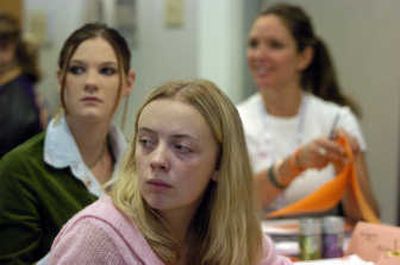Students learn about SAVE

More than 80 high school and middle school students from six local school districts gathered at the Libby Center last week to learn ways to curb violence.
It was part of Students Against Violence Everywhere (SAVE), a student-led national organization that lets students decide which issues they feel need to be tackled in their own schools.
The group started in 1989 in North Carolina. At a party during spring break, 17-year-old Alex Orange was shot and killed when he tried to break up a fight.
Orange’s friends and teachers didn’t want him to have died in vain, so they started a project to give his life meaning. They held a meeting at the school shortly after his death to organize against violence.
The organization has sprung up in schools around the country, and most recently in Spokane, starting at Glover Middle School last March. The meeting at the Libby Center drew students from Cheney, Medical Lake, Nine Mile Falls, Riverside, Deer Park and Spokane Public Schools.
Melissa Anderson, the student assistant specialist at Glover, said that the students this year are very excited about the program.
The group hasn’t had a chance to do any recruiting of new members this school year, but already 20 students are involved. Anderson said that their enthusiasm for SAVE keeps her motivated as well.
“It makes it so easy to keep this club going,” she said.
The students have worked on projects such as an awareness campaign last school year.
The students found out that one in four people are affected by violence in some way, so they started hanging ribbons in the school — three of them were purple and the fourth was purple and orange to represent the one in four people.
She said the group meets for lunch a couple of times a month and decides for themselves which issues to tackle, such as bullying.
“The kids are recognized as people with a nonviolent message,” Anderson said.
The program was such a success last year that the students actually spoke to high school kids about the program.
Seven of her students joined the workshop last week where the kids learned lessons in the elements of SAVE.
There are three elements to SAVE: crime prevention, conflict management and community service projects.
Carleen Wray, assistant director of the national program in North Carolina, ran the students though several exercises at the workshop, such as how to be a good witness.
She separated the students into two groups – witnesses and detectives.
The witnesses were briefly shown a picture of a cartoon bank robbery in progress. The detectives asked the witnesses questions about what they saw, and the students were surprised about what they got right and what they got wrong.
They also discussed the definition of crime and different examples of it such as vandalism, robbery and drugs.
Wray also discussed with the students the importance of telling an adult if they see something dangerous. Many times students are worried about being labeled a tattler, but if someone could get hurt from a dangerous situation, it is important to share it.
“We’re empowering students with knowledge and skill,” Wray said of the program.
Wray was assisted in the presentation by Brett Powers, a senior at Medical Lake High School who is a member of the National Youth Advisory Board of SAVE. There are only nine youth advisory board members in the country from several different states.
Powers said that a counselor at school recommended he get involved in SAVE. Since then, he has founded a SAVE club at his school.
“I love it,” he said. “I get to help people and make the community safer.”
Tammie Shaw, the project coordinator of the Center for Prevention Programs at Educational School District 101, said the kids who participate in SAVE are not necessarily the straight A kids.
“We try to get kids with a wide variety of experience,” she said.
Sallie Christensen of Equity Services at Spokane Public Schools said that she is excited the students get to decide what issues are important to them.
She said the students who attended the workshop will take the ideas they learn and hopefully start their own SAVE club.
“They can make a difference,” Christensen said. “They feel empowered to make change.”
Christensen said that sometime in the spring the same kids that attended last week’s workshop will meet again to discuss everything they have learned and accomplished over the school year.
“I’d love to have one in each of our schools,” Christensen said.